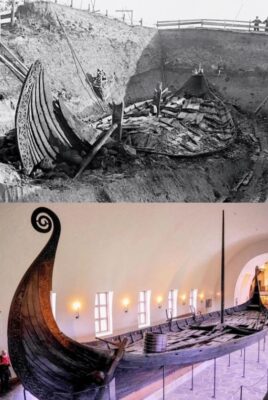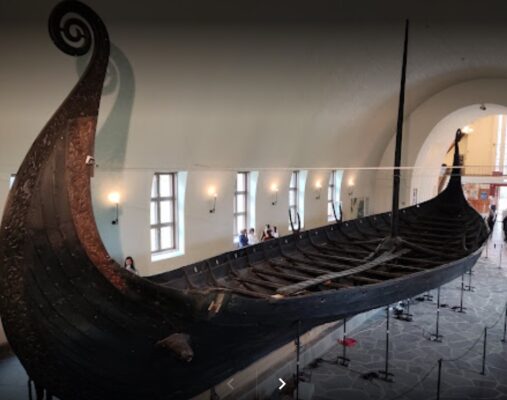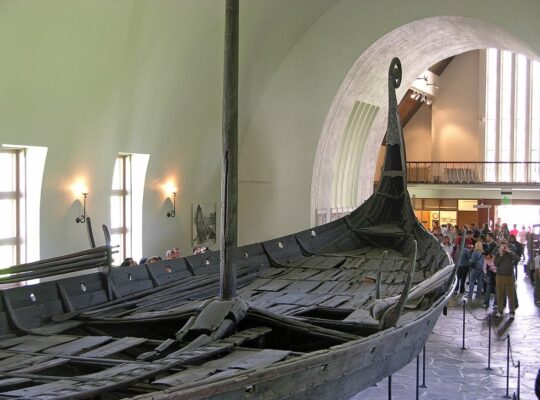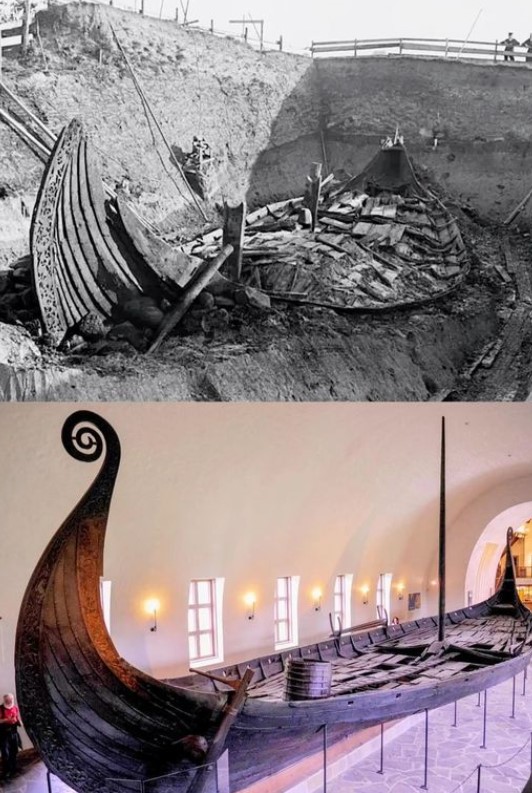The Oseberg Ship one of the most extraordinary and best preserved Viking Age artifacts. Discovered in Norway, this remarkable ship offers unparalleled insights into Viking life, culture and craftsmanship. As one of the most important archaeological finds of its time, the Oseberg continues to fascinate historians, archaeologists and tourists, serving as a symbol of the advanced technology, art and cultural activities of the Vikings. Want to know more about impressive archaeology? Follow archeology.dulichvn.net to learn more about mysterious artifacts.
1. The Discovery of the Oseberg Ship
The Oseberg ship was unearthed in 1904, providing a rare glimpse into the Viking world. This remarkable find has become one of the most celebrated archaeological discoveries in history.

1.1. Location of the Discovery
The Oseberg ship was found in a large burial mound at the Oseberg farm near Tønsberg in Vestfold County, Norway. This area is widely recognized for its rich Viking heritage and numerous archaeological sites. The discovery of the ship in this region highlights its historical importance and the central role of maritime activities in Viking society.
1.2. The Burial Mound
The ship was part of an elaborate burial site, believed to be the final resting place of two high-ranking Viking women. Alongside the ship, archaeologists discovered a wealth of burial goods, including tools, textiles, and ceremonial objects. These artifacts offer invaluable insights into Viking rituals, beliefs, and social structures, showcasing their complex funerary traditions.
1.3. Excavation Highlights
The excavation of the Oseberg ship was meticulously carried out by archaeologists, who unearthed not only the ship but also a treasure trove of items, all remarkably well-preserved. The excavation revealed a vast collection of artifacts, such as household items, clothing, and personal possessions, all of which provide a deeper understanding of the Viking way of life.
2. The Design and Features of the Oseberg Ship
The Oseberg ship’s design is a testament to the Vikings’ advanced shipbuilding techniques and their exceptional craftsmanship. Its well-preserved state allows us to marvel at the remarkable skill and artistry involved in its construction.

2.1. Impeccable Preservation
Despite being buried for over a thousand years, the Oseberg ship remains in extraordinary condition. The ship’s sturdy oak structure and intricate carvings are still visible, showcasing the craftsmanship and ingenuity of its builders. The remarkable preservation of the ship allows modern researchers to study its design and construction in detail, providing a clearer picture of Viking shipbuilding practices.
2.2. Dimensions and Specifications
The Oseberg ship measures approximately 21.5 meters (70.5 feet) in length and 5 meters (16.4 feet) in width. These dimensions make it both a graceful and functional vessel, suitable for both sailing and ceremonial purposes. The ship’s design reflects the Vikings’ mastery of naval architecture, combining elegance with practicality.
2.3. Decorative Details
One of the most striking features of the Oseberg ship is its decorative details. Intricate wood carvings of animals and symbolic patterns adorn the ship, highlighting the Vikings’ artistic skills and cultural expression. These carvings not only served a decorative purpose but also likely held symbolic significance, reflecting the spiritual and cultural beliefs of the Viking people.
3. The Cultural and Historical Significance of the Oseberg Ship
The Oseberg ship is more than just an artifact; it is a symbol of the Viking Age’s enduring legacy. It offers profound insights into Viking society, their burial practices, and their achievements in maritime technology.

3.1. Insights into Viking Society
The artifacts found within the burial mound reveal much about Viking society, including their daily lives, beliefs, and social structures. Tools, textiles, and agricultural equipment provide a snapshot of the Viking economy, while ceremonial objects suggest the spiritual and ritualistic importance of the ship. The Oseberg ship serves as a direct link to the past, shedding light on the complex society that the Vikings built.
3.2. A Reflection of Viking Burial Practices
The Oseberg ship was used as a burial vessel for two prominent women, emphasizing the Vikings’ respect for the afterlife. The elaborate burial site reflects the importance the Vikings placed on honoring their dead and the belief in a journey to the afterlife. This burial practice highlights the social status of the individuals buried with the ship, as well as the intricate rituals associated with Viking funerals.
3.3. A Testament to Maritime Excellence
The Oseberg ship is a remarkable testament to the Vikings’ advanced shipbuilding techniques. As a fully functional longship, it demonstrates the Vikings’ mastery of naval engineering. The ship’s design and construction reflect the Vikings’ prowess as seafarers, capable of navigating vast distances across the seas. The Oseberg ship stands as a lasting symbol of Viking maritime dominance and innovation.
Conclusion
The Oseberg ship is a priceless treasure from the Viking Age, offering unparalleled insights into the artistry, culture, and maritime achievements of this legendary civilization. Its exceptional preservation, intricate design, and the wealth of artifacts discovered alongside it make it a crucial piece of history. Whether you are a history enthusiast or simply curious about Viking heritage, the Oseberg ship is a timeless reminder of the Vikings’ remarkable legacy.


CÁC TIN KHÁC
Mark Twain & Olivia Langdon: A 36-Year Love Story Filled with Laughter and Devotion
The Tollund Man: A 2,400-Year-Old Mystery Preserved in a Danish Bog
Skara Brae: Scotland’s Hidden Neolithic Village
Porta Nigra: The Hidden Depths of Trier’s Iconic Roman Gate